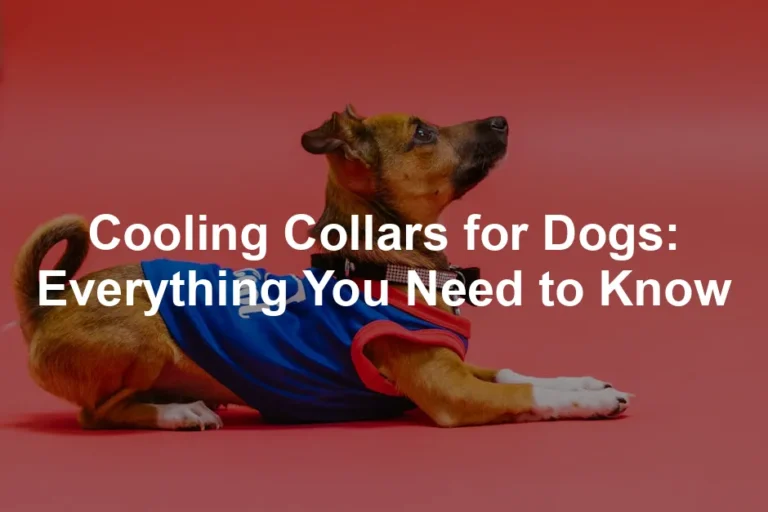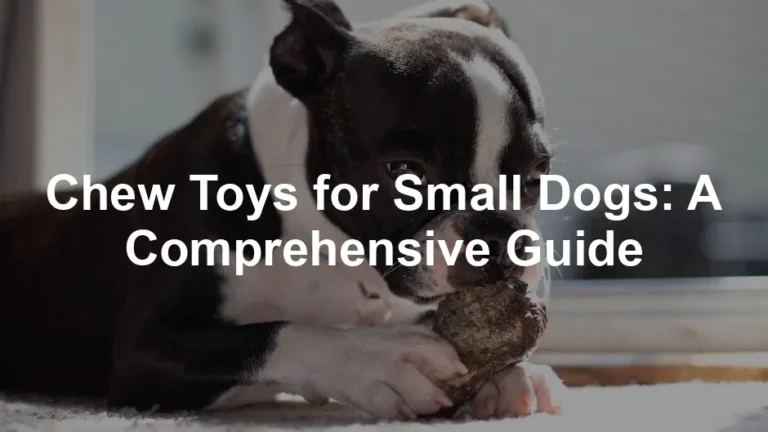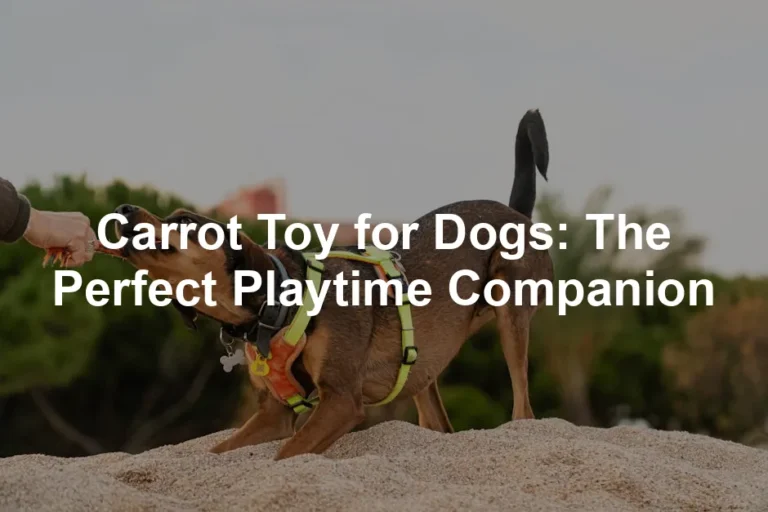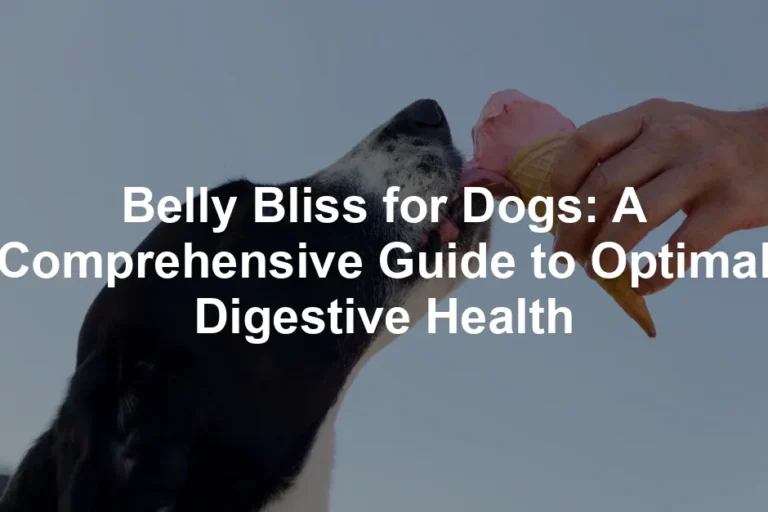Introduction
Understanding your dog’s tail wagging patterns is like cracking a secret code. It’s a vital part of canine communication. Many folks mistakenly believe that a wagging tail always means happiness. Think of that person who grins while plotting your demise—yikes! A wagging tail can express a variety of emotions, ranging from joy to anxiety and even aggression.
This article aims to educate dog owners about interpreting their furry friend’s tail signals effectively. By paying attention to these cues, you can better connect with your pup and respond to their needs. So, next time your dog wags their tail, remember: it’s not just a happy dance, but rather a complex language waiting to be understood. If you’re looking to dive deeper into dog training, check out “The Art of Raising a Puppy” by The Monks of New Skete.

Understanding Canine Tail Communication
The Role of the Tail in Dog Communication
A dog’s tail serves as a powerful communication tool. It’s like the dog’s version of a mood ring, revealing a range of emotions. Whether wagging, tucked, or held high, the tail offers insights into how your dog feels. A wagging tail doesn’t automatically signal friendship; it often conveys much more.
Think of the tail as a signal flag. When dogs interact with each other or humans, their tails speak volumes. For instance, a fast, broad wag often means excitement, while a slow, low wag might indicate uncertainty. The position and movement of the tail can communicate everything from eagerness to fear.
Research shows that dogs also read each other’s tail movements. They can distinguish between a happy wag and one that might signal a threat. The ability to interpret these signals helps dogs navigate their social interactions, ensuring they stay safe and understood. So next time you see your dog wagging their tail, consider it a fascinating peek into their emotional world.
In short, tail wags are rich in meaning. Understanding these nuances can enhance our relationships with our dogs and lead to better communication. And while you’re at it, treat your pup with some Blue Buffalo Wilderness Trail Treats. They’ll love you for it!

Key Factors in Tail Communication
Tail Position
The position of your dog’s tail is a fascinating indicator of their emotional state. A tail held high often signifies confidence and excitement. It’s like your dog strutting down the street with its head held high, ready to conquer the world! Conversely, a low tail can indicate fear or submission, much like a child hiding behind their parent during a scary movie. When the tail is tucked between the legs, your furry friend is likely feeling anxious or threatened. In this position, it’s as if they’re trying to disappear into the floor—definitely a clear sign that they need some comfort and reassurance.
To help your dog feel safe and secure, consider using a PetSafe Easy Walk Dog Harness. It offers comfort and control during walks, making your outings more enjoyable!

Wag Speed
Now, let’s talk about wag speed. Ever seen a dog with a tail wagging like there’s no tomorrow? That rapid wag often reflects pure joy and excitement! It’s the canine equivalent of a child bouncing up and down at a birthday party. On the flip side, a slow wag may indicate hesitation or uncertainty, like a teenager contemplating whether to ask someone out. When the wagging is barely perceptible, your pup may be feeling insecure or cautious, so it’s best to approach them gently.
Directional Wagging
Here’s where things get really interesting: the direction of the wag! Studies suggest that dogs wagging their tails to the right tend to experience positive emotions. It’s like they’re waving a flag of happiness, welcoming you with open paws. In contrast, a left-sided wag may indicate negative feelings, such as stress or anxiety. Imagine your dog as a little emotional compass, guiding you through their feelings. So, next time your dog greets you with a wag, pay attention to which side they’re favoring. It could reveal more than just their mood; it might just help you understand what’s going on in that adorable head of theirs!
Specific Wag Patterns
Full Body Wag
The “full body wag” resembles a canine dance party! When your dog wags not just its tail but its whole body, it’s a clear sign of joy. Imagine your pup bouncing around like they’ve just seen their best friend after a long separation. This exuberant wagging often indicates excitement, happiness, and a welcoming spirit. If your dog’s eyes are bright and their body language is loose, you’re witnessing pure canine bliss. Think of it as their way of saying, “Life is good, and I’m thrilled you’re here!”

Circle Wag
Now, if you notice your dog performing a “circle wag,” prepare for a cuteness overload! This wag involves the tail spinning in a circular motion, often accompanied by a whole-body wiggle. Circle wags typically signal extreme happiness, especially when your dog is greeting someone they adore. It’s like your pup is saying, “I’m so excited to see you! Let’s celebrate!” This wag is often seen in dogs after a fun day or during playtime. If your dog breaks out this wiggly dance, get ready for a joyous reunion!
Slow Wag
A slow wag can feel like a canine conundrum. Unlike the vibrant wags, a slow tail movement indicates hesitation or insecurity. Picture this: your dog is cautiously approaching a new situation or person, and their tail is moving at a snail’s pace. This wag might occur during introductions or in unfamiliar environments. If you observe a slow wag, it’s best to approach your dog gently. This behavior suggests they may need reassurance, so offer them comfort and patience to help them feel safe.

Breed-Specific Tail Wagging Patterns
How Tail Types Affect Wagging
Dogs come in all shapes and sizes, and so do their tails! Different breeds have unique tail shapes and lengths that influence their wagging styles. For instance, herding breeds like Border Collies often wag their tails in a lower position, reflecting their focused nature. This controlled wagging is part of their instinctual behavior while working with livestock. In contrast, toy breeds like Pugs have short, curly tails that wiggle more than they wag. This adds a delightful charm to their communication style, making their happy moments extra adorable!
Additionally, the tail type can affect visibility. Long-tailed breeds, such as Golden Retrievers, showcase their emotions easily with big, sweeping wags. However, short-tailed breeds might not convey feelings as visibly. Their tail movements, while still expressive, can be subtler. Understanding these breed-specific behaviors is crucial for interpreting tail signals accurately. So, whether your dog’s tail is a whip-like signal or a curly cue, each wag tells a unique story!

The Importance of Context in Tail Interpretation
Observing the Surrounding Environment
Understanding your dog’s tail wagging patterns requires a keen eye on their environment. Dogs are sensitive creatures, and their tail movements can change dramatically based on what’s happening around them. Picture a dog wagging its tail in a park full of friends and other pooches—pure joy! Now, imagine the same dog at the vet, where the tail might droop as if it’s packing for a long trip to the moon.
Environmental factors play a crucial role. A wagging tail can mean excitement, but it might also signal anxiety if your pup is in an unfamiliar place. For instance, if your dog wags its tail while standing rigidly near a new dog, it may be anxious rather than welcoming. This is why looking beyond the tail to other body language signals is essential. Posture, ear position, and facial expressions can all provide valuable clues. A relaxed body and soft eyes indicate comfort, while tense muscles and pinned ears might suggest fear or aggression. So, remember: context is king when interpreting your dog’s tail signals!

Tail Wagging and Social Interactions
Social interactions also influence how dogs express themselves through tail wagging. When meeting familiar faces, dogs often exhibit joyous, full-body wags that scream “I missed you!” It’s a vibrant display of affection. Conversely, when encountering new individuals or animals, the wagging might shift to a more cautious rhythm. Think of it as your dog’s way of saying, “Hello, I’m friendly, but let’s keep it cool!”
Dogs can even tailor their tail wags based on their previous experiences. A pup that’s had positive interactions with other dogs will likely show enthusiasm when greeting them. However, if a dog has faced negativity—like being growled at or bitten—their tail wag might come with hesitance, signaling insecurity. This adaptability in tail wagging reveals the complexities of canine social behavior. So, next time your dog meets someone new, pay close attention to those tail movements; they might be telling you more than you think!

Practical Tips for Dog Owners
Observing and Responding to Tail Signals
Now that you’re aware of the importance of context, let’s discuss practical steps for observing and interpreting your dog’s tail wagging. First, take a moment to watch your dog in different scenarios. Is their tail wagging high and fast when you come home? That’s a great sign of excitement! But if they’re wagging slowly while meeting a new dog, it’s time to tread cautiously.
Next, respond to their signals accordingly. If you notice a slow wag, approach your dog gently and offer reassurance. This could mean they’re feeling anxious, and your calm presence can help ease their worries. On the flip side, if their tail is wagging like a helicopter, engage in playtime or give them some affectionate pets. This positive reinforcement encourages their happy behavior!
Lastly, be patient and observant. Each dog is unique, and learning their individual signals takes time. By tuning into your dog’s emotions through tail wagging, you’ll strengthen your bond and create an environment where both of you feel comfortable and understood. So, keep an eye on that tail—it’s a window into your dog’s heart!

Building a Stronger Bond
Understanding your dog’s tail wagging patterns is more than a fun party trick. It’s a key ingredient to a stronger, more meaningful bond between you and your furry friend. When you grasp what those wagging tails really mean, you’re stepping into a deeper level of communication.
Picture this: Your dog wags its tail, and you instantly recognize whether it’s a happy wag or an anxious one. This insight allows you to respond appropriately, offering comfort or playtime as needed. When you tune into your dog’s feelings, it builds trust. They start to see you as their go-to source for support or fun, rather than just a meal provider.
Moreover, your relationship flourishes when you can identify when your dog needs space or moments of affection. A well-timed scratch behind the ears during a low wag can mean the world to a nervous pup. Alternatively, engaging in a game of fetch when their tail is a blur of excitement ensures they feel understood and valued. And while you’re at it, don’t forget to keep their playtime exciting with KONG Classic Dog Toy.

The more you understand your dog’s tail communication, the better you can cater to their emotional needs. This creates a harmonious environment where both of you thrive. Ultimately, recognizing tail signals enhances your bond, transforming your relationship into a beautiful partnership built on mutual respect and affection. Tail wagging isn’t just a signal; it’s a bridge to a richer connection.
Conclusion
In summary, interpreting your dog’s tail wagging patterns is vital for effective communication. Throughout this article, we highlighted how tails serve as a powerful communication tool. It’s essential to remember that a wagging tail doesn’t always signify happiness. By understanding the nuances of tail position, speed, and direction, you can gain insights into your dog’s emotional state.
Observing your dog’s tail movements can help you respond appropriately to their needs, whether they require comfort during anxious moments or playtime during excited ones. Notably, recognizing these patterns can enhance your bond, fostering trust and understanding. And to keep your dog clean and fresh, try using Nature’s Miracle Oatmeal Dog Shampoo. It’s a great way to pamper your pup!

So, the next time your dog greets you with a wag, take a moment to consider what that tail is really saying. By doing so, you’re not only improving your communication with your furry friend but also deepening the loving relationship you both cherish. After all, every wag tells a story—make sure you’re listening!
FAQs
What does it mean if my dog wags its tail while lying down?
When your dog wags its tail while lying down, it typically indicates relaxation combined with mild interest. This behavior suggests your pup is comfortable and content in their environment, possibly enjoying your presence or something happening nearby.
How can I tell if my dog is anxious despite wagging its tail?
It’s essential to look at the entire picture. If your dog is wagging its tail but also has a tense body posture, pinned ears, or is avoiding eye contact, they may be feeling anxious. A slow or low wag can also signal insecurity, even if the tail is moving.
Why does the direction of tail wagging matter?
The direction of tail wagging can provide insight into your dog’s emotional state. Studies suggest that dogs wagging their tails to the right tend to experience positive emotions, while those wagging to the left may be feeling negative emotions or stress.
Can tail wagging indicate health problems?
Yes, changes in tail behavior can sometimes signal health issues. If your dog suddenly stops wagging their tail or if you notice unusual patterns, it might be a good idea to consult a veterinarian to rule out any underlying health concerns.
Is it true that all dogs wag their tails the same way?
Not at all! Individual personality and breed characteristics can lead to different wagging styles. For example, a Greyhound might have a more subtle wag compared to a Beagle, which wags its tail enthusiastically. Understanding your dog’s unique style is crucial for interpreting their emotions accurately.
Please let us know what you think about our content by leaving a comment down below!
Thank you for reading till here 🙂
To learn more about how to interpret your dog’s tail wagging patterns, check out our detailed guide on how to interpret your dog’s tail wagging patterns.
And for those rainy days, don’t forget to grab some Furhaven Pet Dog Bed for your furry friend to lounge in style!
All images from Pexels





